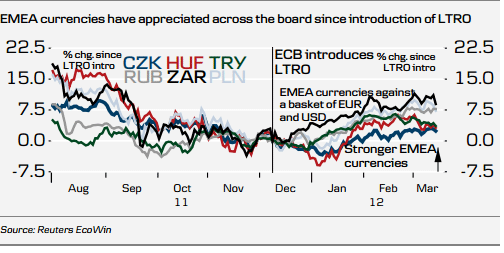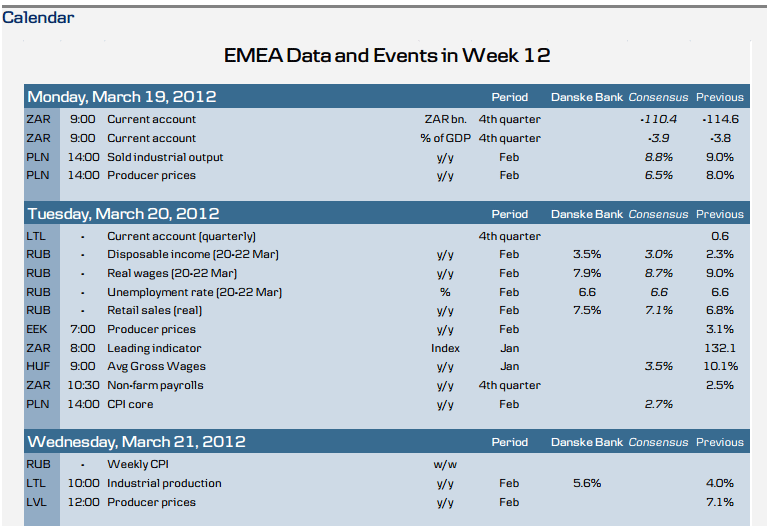Global risk sentiment has turned decisively more positive since December. In our view, this is clearly a result of the ECB’s much more accommodative stance on 8 December with, among other things, the introduction of the so-called 3-year LTRO.
The change in global risk sentiment from December has been clearly visible in the EMEA markets as well. As the graph at the bottom of this page shows, we have seen a clear change in the direction of the EMEA currencies, and all of the EMEA currencies that we regularly do forecasts on have strengthened since 8 December. This, in our view, is not a coincidence. The ECB’s actions have significantly reduced the risk of a catastrophic event in the euro, which for very natural reasons is positive for the EMEA markets.
However, while the EMEA currencies were clearly trending stronger during DecemberJanuary, the picture has been less clear over the past month. Hence, since early February the EMEA currencies have overall traded sideways against the euro and the dollar. This is probably a reflection of the fact that the good news from the introduction of the 3-year LTRO now has been more or less fully priced in.
It is therefore now natural to ask the question whether it is time to turn more negative. In our view, that is not the case as we think that the change in global monetary conditions will continue to lend support to the EMEA currency.
However, we also acknowledge that more monetary easing from the major central banks might not be forthcoming in the short term, and furthermore, valuation of the EMEA currencies certainly looks less attractive than was the case in early December.
We therefore believe that the moderate bullish environment is likely to be maintained for the remainder of the year and, in general, have a fairly upbeat outlook for the EMEA currencies. However, we would stand ready to turn more negative on the EMEA currencies, especially if the ECB and Federal Reserve once again start to move in a less accommodative direction due to potentially higher inflation. There certainly is a risk that especially the ECB once again tightens monetary policy prematurely – as was the case in 2011. However, for now we think the ECB has learned the lesson and will be less aggressive than for example in 2011. 


- English (UK)
- English (India)
- English (Canada)
- English (Australia)
- English (South Africa)
- English (Philippines)
- English (Nigeria)
- Deutsch
- Español (España)
- Español (México)
- Français
- Italiano
- Nederlands
- Português (Portugal)
- Polski
- Português (Brasil)
- Русский
- Türkçe
- العربية
- Ελληνικά
- Svenska
- Suomi
- עברית
- 日本語
- 한국어
- 简体中文
- 繁體中文
- Bahasa Indonesia
- Bahasa Melayu
- ไทย
- Tiếng Việt
- हिंदी
Liquidity Driven Rally Set to Continue
Published 03/17/2012, 08:18 AM
Updated 05/14/2017, 06:45 AM
Liquidity Driven Rally Set to Continue
Latest comments
Loading next article…
Install Our App
Risk Disclosure: Trading in financial instruments and/or cryptocurrencies involves high risks including the risk of losing some, or all, of your investment amount, and may not be suitable for all investors. Prices of cryptocurrencies are extremely volatile and may be affected by external factors such as financial, regulatory or political events. Trading on margin increases the financial risks.
Before deciding to trade in financial instrument or cryptocurrencies you should be fully informed of the risks and costs associated with trading the financial markets, carefully consider your investment objectives, level of experience, and risk appetite, and seek professional advice where needed.
Fusion Media would like to remind you that the data contained in this website is not necessarily real-time nor accurate. The data and prices on the website are not necessarily provided by any market or exchange, but may be provided by market makers, and so prices may not be accurate and may differ from the actual price at any given market, meaning prices are indicative and not appropriate for trading purposes. Fusion Media and any provider of the data contained in this website will not accept liability for any loss or damage as a result of your trading, or your reliance on the information contained within this website.
It is prohibited to use, store, reproduce, display, modify, transmit or distribute the data contained in this website without the explicit prior written permission of Fusion Media and/or the data provider. All intellectual property rights are reserved by the providers and/or the exchange providing the data contained in this website.
Fusion Media may be compensated by the advertisers that appear on the website, based on your interaction with the advertisements or advertisers.
Before deciding to trade in financial instrument or cryptocurrencies you should be fully informed of the risks and costs associated with trading the financial markets, carefully consider your investment objectives, level of experience, and risk appetite, and seek professional advice where needed.
Fusion Media would like to remind you that the data contained in this website is not necessarily real-time nor accurate. The data and prices on the website are not necessarily provided by any market or exchange, but may be provided by market makers, and so prices may not be accurate and may differ from the actual price at any given market, meaning prices are indicative and not appropriate for trading purposes. Fusion Media and any provider of the data contained in this website will not accept liability for any loss or damage as a result of your trading, or your reliance on the information contained within this website.
It is prohibited to use, store, reproduce, display, modify, transmit or distribute the data contained in this website without the explicit prior written permission of Fusion Media and/or the data provider. All intellectual property rights are reserved by the providers and/or the exchange providing the data contained in this website.
Fusion Media may be compensated by the advertisers that appear on the website, based on your interaction with the advertisements or advertisers.
© 2007-2025 - Fusion Media Limited. All Rights Reserved.
